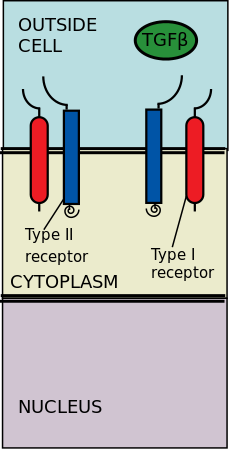

The upstream signaling pathway is triggered by the binding of a signaling molecule, a ligand, to a receiving molecule, a receptor. Receptors and ligands exist in many different forms, and only recognize/bond to particular molecules. Upstream extracellular signaling transduce a variety of intracellular cascades.[1]
Receptors and ligands are common upstream signaling molecules that dictate the downstream elements of the signal pathway. A plethora of different factors affect which ligands bind to which receptors and the downstream cellular response that they initiate.
- ^ Miller DS, Schmierer B, Hill CS (July 2019). "TGF-β family ligands exhibit distinct signalling dynamics that are driven by receptor localisation". Journal of Cell Science. 132 (14): jcs234039. doi:10.1242/jcs.234039. PMC 6679586. PMID 31217285.